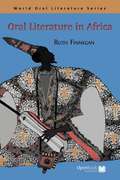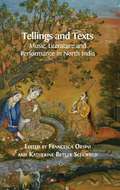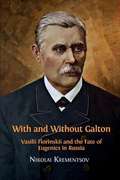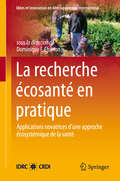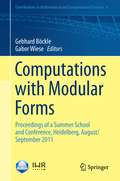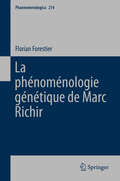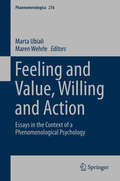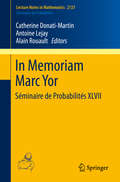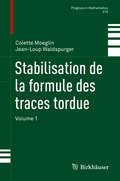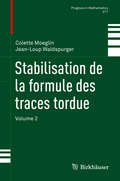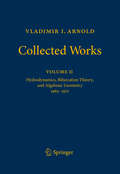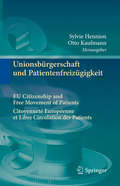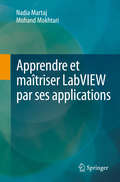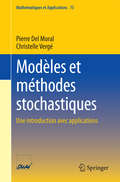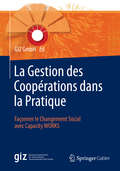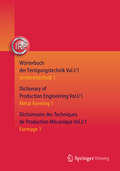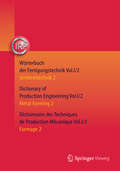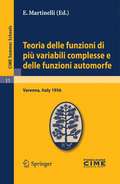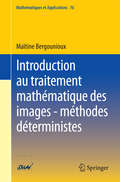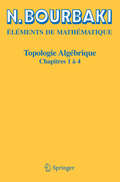- Table View
- List View
Open Education: International Perspectives In Higher Education
by Patrick Blessinger Tj BlissThis insightful collection of essays explores the ways in which open education can democratise access to education for all. It is a rich resource that offers both research and case studies to relate the application of open technologies and approaches in education settings around the world. A must-read for practitioners, policy-makers, scholars and students in the field of education.
Oral Literature in Africa
by Ruth FinneganRuth Finnegan’s Oral Literature in Africa was first published in 1970, and since then has been widely praised as one of the most important books in its field. Based on years of fieldwork, the study traces the history of storytelling across the continent of Africa. This revised edition makes Finnegan’s ground-breaking research available to the next generation of scholars. It includes a new introduction, additional images and an updated bibliography, as well as its original chapters on poetry, prose, "drum language" and drama, and an overview of the social, linguistic and historical background of oral literature in Africa. Oral Literature in Africa has been accessed by hundreds of readers in over 60 different countries, including Ethiopia, Kenya, Rwanda and numerous other African countries. The digital editions of this book are free to download thanks to the generous support of interested readers and organisations, who made donations using the crowd-funding website Unglue.it. Oral Literature in Africa is part of our World Oral Literature Series in conjunction with the World Oral Literature Project.
Searching for Sharing: Heritage And Multimedia In Africa (World Oral Literature Ser. #Vol. 7)
by Daniela Merolla Mark TurinIn a world where new technologies are being developed at a dizzying pace, how can we best approach oral genres that represent heritage? Taking an innovative and interdisciplinary approach, this volume explores the idea of sharing as a model to construct and disseminate the knowledge of literary heritage with the people who are represented by and in it. Expert contributors interweave sociological analysis with an appraisal of the transformative impact of technology on literary and cultural production. Does technology restrict, constraining the experience of an oral performance, or does it afford new openings for different aesthetic experiences? Topics explored include the Mara Cultural Heritage Digital Library, the preservation of Ewe heritage material, new eresources for texts in Manding languages, and the possibilities of technauriture. This timely and necessary collection also examines to what extent digital documents can be and have been institutionalised in archives and museums, how digital heritage can remain free from co-option by hegemonic groups, and the roles that exist for community voices. A valuable contribution to a fast-developing field, this book is required reading for scholars and students in the fields of heritage, anthropology, linguistics, history and the emerging disciplines of multi-media documentation and analysis, as well as those working in the field of literature, folklore, and African studies. It is also important reading for museum and archive curators. The University of Leiden has generously contributed to the publication of this volume.
Tellings and Texts: Music, Literature And Performance In North India
by Francesca Orsini Katherine Butler SchofieldExamining materials from early modern and contemporary North India and Pakistan, Tellings and Texts brings together seventeen first-rate papers on the relations between written and oral texts, their performance, and the musical traditions these performances have entailed. The contributions from some of the best scholars in the field cover a wide range of literary genres and social and cultural contexts across the region. The texts and practices are contextualized in relation to the broader social and political background in which they emerged, showing how religious affiliations, caste dynamics and political concerns played a role in shaping social identities as well as aesthetic sensibilities. By doing so this book sheds light into theoretical issues of more general significance, such as textual versus oral norms; the features of oral performance and improvisation; the role of the text in performance; the aesthetics and social dimension of performance; the significance of space in performance history and important considerations on repertoires of story-telling. The book also contains links to audio files of some of the works discussed in the text. Tellings and Texts is essential reading for anyone with an interest in South Asian culture and, more generally, in the theory and practice of oral literature, performance and story-telling.
Thomas Annan of Glasgow: Pioneer Of The Documentary Photograph
by Lionel GossmanIn the wake of Glasgow’s transformation in the nineteenth-century into an industrial powerhouse, the "Second City of the Empire,” a substantial part of the old town of Adam Smith degenerated into an overcrowded and disease-ridden slum. The Old Closes and Streets of Glasgow, Thomas Annan’s photographic record of this central section of the city prior to its demolition in accordance with the City of Glasgow Improvements Act of 1866, is widely recognized as a classic of nineteenth-century documentary photography. Annan’s achievement as a photographer of paintings and a portrait and landscape photographer is less widely known. Thomas Annan: Photographer of Victorian Scotland offers a handy, comprehensive and copiously illustrated overview of the full range of the photographer’s work. The book opens with a brief account of the immediate context of Annan’s career as a photographer: the astonishing florescence of photography in Victorian Scotland. Successive chapters deal with each of the main fields of his activity, touching along the way on issues such as the nineteenth-century debate over the status of photography — a mechanical practice or an artistic one? — and the still ongoing controversies surrounding the documentary photograph in particular. While the text itself is intended for the general reader, extensive endnotes amplify particular themes and offer guidance to readers interested in pursuing these themes further.
Vertical Readings in Dante's Comedy
by George Corbett Heather WebbVertical Readings in Dante’s Comedy is a reappraisal of the poem by an international team of thirty-four scholars. Each vertical reading analyses three same-numbered cantos from the three canticles: Inferno i, Purgatorio i and Paradiso i; Inferno ii, Purgatorio ii and Paradiso ii; etc. Although scholars have suggested before that there are correspondences between same-numbered cantos that beg to be explored, this is the first time that the approach has been pursued in a systematic fashion across the poem. This collection – to be issued in three volumes – offers an unprecedented repertoire of vertical readings for the whole poem. As the first volume exemplifies, vertical reading not only articulates unexamined connections between the three canticles but also unlocks engaging new ways to enter into core concerns of the poem. The three volumes thereby provide an indispensable resource for scholars, students and enthusiasts of Dante. The volume has its origin in a series of thirty-three public lectures held in Trinity College, the University of Cambridge (2012-2016) which can be accessed at the ‘Cambridge Vertical Readings in Dante’s Comedy’ website. This series would not have been possible without the generosity of certain sponsors: Trinity College; Selwyn College; the Italian Department, University of Cambridge; the Cambridge Italian Research Network (CIRN); the Centre for Medieval Literature (University of Southern Denmark and University of York); the University of Notre Dame; and the School of Languages, Cultures and Societies, University of Leeds.
Vertical Readings in Dante's Comedy: Volume 3
by George Corbett Heather WebbVertical Readings in Dante’s Comedy is a reappraisal of the poem by an international team of thirty-four scholars. Each vertical reading analyses three same-numbered cantos from the three canticles: Inferno i, Purgatorio i and Paradiso i; Inferno ii, Purgatorio ii and Paradiso ii; etc. Although scholars have suggested before that there are correspondences between same-numbered cantos that beg to be explored, this is the first time that the approach has been pursued in a systematic fashion across the poem. This collection in three volumes offers an unprecedented repertoire of vertical readings for the whole poem. As the first volume exemplifies, vertical reading not only articulates unexamined connections between the three canticles but also unlocks engaging new ways to enter into core concerns of the poem. The three volumes thereby provide an indispensable resource for scholars, students and enthusiasts of Dante. The volume has its origin in a series of thirty-three public lectures held in Trinity College, the University of Cambridge (2012-2016) which can be accessed at the Cambridge Vertical Readings in Dante’s Comedy website.
With and Without Galton: Vasilii Florinskii And The Fate Of Eugenics In Russia
by Nikolai KrementsovIn 1865, British polymath Francis Galton published his initial thoughts about the scientific field that would become ‘eugenics.’ The same year, Russian physician Vasilii Florinskii addressed similar issues in a sizeable treatise, entitled Human Perfection and Degeneration. Initially unheralded, Florinskii’s book would go on to have a remarkable afterlife in twentieth- and twenty-first-century Russia. In this lucid and insightful work, Nikolai Krementsov argues that the concept of eugenics brings together ideas, values, practices, and fears energised by a focus on the future. It has proven so seductive to different groups over time because it provides a way to grapple with fundamental existential questions of human nature and destiny. With and Without Galton develops this argument by tracing the life-story of Florinskii’s monograph from its uncelebrated arrival amid the Russian empire’s Great Reforms, to its reissue after the Bolshevik Revolution, its decline under Stalinism, and its subsequent resurgence: first, as a founding document of medical genetics, and most recently, as a manifesto for nationalists and racial purists. Krementsov’s meticulously researched ‘biography of a book’ sheds light not only on the peculiar fate of eugenics in Russia, but also on its convoluted transnational history, elucidating the field’s protean nature and its continuing and contested appeal to diverse audiences, multiple local trajectories, and global trends. It is required reading for historians of eugenics, science, medicine, education, literature, and Russia, and it will also appeal to the general reader looking for a deeper understanding of this challenging subject. Victoria College, University of Toronto, has generously contributed to the publication of this volume.
La Recherche Écosanté en pratique: Applications novatrices d’une approche écosystémique de la santé (Insight and Innovation in International Development #2)
by Dominique F. CharronPrès de vingt ans après la Conférence des Nations Unies sur l’environnement et le développement (le Sommet de Rio), la nécessité d’atténuer la pauvreté et d’améliorer les conditions de vie grâce à un accès plus équitable aux ressources, à l’utilisation judicieuse de ces dernières et à des milieux ambiants plus sains est toujours aussi vive. Conscients que la santé humaine est intimement liée aux écosystèmes, les chercheurs tracent de nouvelles voies vers un avenir plus durable. Une approche écosystémique de la santé, alliant la recherche et la pratique dans des domaines aussi variés que la gestion de l’environnement, la santé publique, la biodiversité et le développement économique, se fonde sur la conviction que l’être humain fait partie intégrante de systèmes socio-écologiques complexes. En présentant des études de cas menées dans diverses régions du monde, La Recherche Écosanté en pratique rend compte de pratiques novatrices en agriculture, gestion des ressources naturelles, renforcement des collectivités et prévention des maladies témoignant des plus récents progrès en ce qui concerne la recherche, ses applications et l’élaboration de politiques dans le domaine. Le livre montre les rouages de la recherche en écosanté et illustre comment elle a produit des changements qui ont amélioré de manière durable les conditions de vie des populations et les écosystèmes les soutenant. Dominique F. Charron dirige le programme Écosystèmes et santé humaine (Écosanté) du CRDI, qui examine les liens entre l’environnement et la santé humaine dans les pays en développement. Elle possède un doctorat en épidémiologie et un doctorat en médecine vétérinaire de l’Université de Guelph. En plus d’être fort instructif, cet ouvrage est une source d’inspiration. Les chapitres d’ouverture, la description des projets de recherche et les chapitres de clôture qui analysent la portée et les défis de l’écosanté forment un tout qui prouve à quel point il s’agit d’un domaine dynamique et en évolution constante doté d’une mission claire et animé par une communauté de praticiens scientifique toujours plus large.Mario–Henry RodríguezDirecteur général, Instituto Nacional de Salud Pública, Mexique
Computations with Modular Forms: Proceedings of a Summer School and Conference, Heidelberg, August/September 2011 (Contributions in Mathematical and Computational Sciences #6)
by Gebhard Böckle Gabor WieseThis volume contains original research articles, survey articles and lecture notes related to the Computations with Modular Forms 2011 Summer School and Conference, held at the University of Heidelberg. A key theme of the Conference and Summer School was the interplay between theory, algorithms and experiment.The 14 papers offer readers both, instructional courses on the latest algorithms for computing modular and automorphic forms, as well as original research articles reporting on the latest developments in the field.The three Summer School lectures provide an introduction to modern algorithms together with some theoretical background for computations of and with modular forms, including computing cohomology of arithmetic groups, algebraic automorphic forms, and overconvergent modular symbols.The 11 Conference papers cover a wide range of themes related to computations with modular forms, including lattice methods for algebraic modular forms on classical groups, a generalization of the Maeda conjecture, an efficient algorithm for special values of p-adic Rankin triple product L-functions, arithmetic aspects and experimental data of Bianchi groups, a theoretical study of the real Jacobian of modular curves, results on computing weight one modular forms, and more.
La phénoménologie génétique de Marc Richir (Phaenomenologica #214)
by Florian ForestierCet ouvrage est la première tentative de présenter une analyse approfondie et synthétisant des théories phénoménologique de Marc Richir. L’étude compare systématiquement son œuvre avec celle d’Edmund Husserl, et montre que la phénoménologie richirienne se présente comme une phénoménologie ‘transcendantale génétique’ qui se développe en dialogue avec Husserl, dont les écrits donnent presque toujours son point de départ problématique et méthodologique. L’auteur établi que la phénoménologie richirienne est, en soi, une refondation globale et systématique de la phénoménologie. Il décrit la manière dont Richir clarifie et reformule les analyses d’Husserl, dont il enquête sur les bases d’œuvre Husserlienne, et dont il mettre en pratique divers théories Husserlienne aux manières imprévues par le philosophe austro-allemande. Ce livre examine l’éventail entier des pensées de Marc Richir, y compris ses écrits sur la perception, la temps, l’espace, ainsi que le schématisme. L’analyse couvre l’approche Richirienne des dimensions de l’expérience (les rêves, par exemple) qui étaient, pour Husserl, périphérique, ainsi que de l'interprétation du philosophe Français des concepts tels que réduction, eidétique, idéalité et intersubjectivité. En plaçant le travail de Richir dans un contexte plus large de la tradition Français de la philosophie, et en évaluant la pertinence de son œuvre au développement du projet phénoménologique en cours, cet ouvrage a apporté une contribution essentielle à la littérature académique.
Feeling and Value, Willing and Action: Essays in the Context of a Phenomenological Psychology (Phaenomenologica #216)
by Marta Ubiali Maren WehrleThis volume explores the role and status of phenomena such as feelings, values, willing, and action in the domain of perception and (social) cognition, as well as the way in which they are related. In its exploration, the book takes Husserl’s lifelong project Studien zur Struktur des Bewusstseins (1909-1930) as its point of departure, and investigates these phenomena with Husserl but also beyond Husserl. Divided into two parts, the volume brings together essays that address the topics from different phenomenological, philosophical, and psychological perspectives. They discuss Husserl’s position in dialogue with historical and recent philosophical and psychological debates and develop phenomenological accounts and descriptions with the help of Geiger, Heidegger, Merleau-Ponty, Plessner, Sartre, Scheler, Schopenhauer, and Reinach.
In Memoriam Marc Yor - Séminaire de Probabilités XLVII (Lecture Notes in Mathematics #2137)
by Catherine Donati-Martin Antoine Lejay Alain RouaultThis volume is dedicated to the memory of Marc Yor, who passed away in 2014. The invited contributions by his collaborators and former students bear testament to the value and diversity of his work and of his research focus, which covered broad areas of probability theory. The volume also provides personal recollections about him, and an article on his essential role concerning the Doeblin documents.With contributions by P. Salminen, J-Y. Yen & M. Yor; J. Warren; T. Funaki; J. Pitman& W. Tang; J-F. Le Gall; L. Alili, P. Graczyk & T. Zak; K. Yano & Y. Yano; D. Bakry & O. Zribi; A. Aksamit, T. Choulli & M. Jeanblanc; J. Pitman; J. Obloj, P. Spoida & N. Touzi; P. Biane; J. Najnudel; P. Fitzsimmons, Y. Le Jan & J. Rosen; L.C.G. Rogers & M. Duembgen; E. Azmoodeh, G. Peccati & G. Poly, timP-L Méliot, A. Nikeghbali; P. Baldi; N. Demni, A. Rouault & M. Zani; N. O'Connell; N. Ikeda & H. Matsumoto; A. Comtet & Y. Tourigny; P. Bougerol; L. Chaumont; L. Devroye & G. Letac; D. Stroock and M. Emery.
Stabilisation de la formule des traces tordue: Volume 1 (Progress in Mathematics #316)
by Colette Moeglin Jean-Loup WaldspurgerCe travail en deux volumes donne la preuve de la stabilisation de la formule des trace tordue.Stabiliser la formule des traces tordue est la méthode la plus puissante connue actuellement pour comprendre l'action naturelle du groupe des points adéliques d'un groupe réductif, tordue par un automorphisme, sur les formes automorphes de carré intégrable de ce groupe. Cette compréhension se fait en réduisant le problème, suivant les idées de Langlands, à des groupes plus petits munis d'un certain nombre de données auxiliaires; c'est ce que l'on appelle les données endoscopiques. L'analogue non tordu a été résolu par J. Arthur et dans ce livre on suit la stratégie de celui-ci.Publier ce travail sous forme de livre permet de le rendre le plus complet possible. Les auteurs ont repris la théorie de l'endoscopie tordue développée par R. Kottwitz et D. Shelstad et par J.-P. Labesse. Ils donnent tous les arguments des démonstrations même si nombre d'entre eux se trouvent déjà dans les travaux d'Arthur concernant le cas de la formule des traces non tordue.Ce travail permet de rendre inconditionnelle la classification que J. Arthur a donnée des formes automorphes de carré intégrable pour les groupes classiques quasi-déployés, c’était pour les auteurs une des principales motivations pour l’écrire.Cette première partie comprend les chapitres préparatoires (I-V).
Stabilisation de la formule des traces tordue: Volume 2 (Progress in Mathematics #317)
by Colette Moeglin Jean-Loup WaldspurgerCe travail en deux volumes donne la preuve de la stabilisation de la formule des trace tordue. Stabiliser la formule des traces tordue est la méthode la plus puissante connue actuellement pour comprendre l'action naturelle du groupe des points adéliques d'un groupe réductif, tordue par un automorphisme, sur les formes automorphes de carré intégrable de ce groupe. Cette compréhension se fait en réduisant le problème, suivant les idées de Langlands, à des groupes plus petits munis d'un certain nombre de données auxiliaires; c'est ce que l'on appelle les données endoscopiques. L'analogue non tordu a été résolu par J. Arthur et dans ce livre on suit la stratégie de celui-ci. Publier ce travail sous forme de livre permet de le rendre le plus complet possible. Les auteurs ont repris la théorie de l'endoscopie tordue développée par R. Kottwitz et D. Shelstad et par J.-P. Labesse. Ils donnent tous les arguments des démonstrations même si nombre d'entre eux se trouvent déjà dans les travaux d'Arthur concernant le cas de la formule des traces non tordue. Ce travail permet de rendre inconditionnelle la classification que J. Arthur a donnée des formes automorphes de carré intégrable pour les groupes classiques quasi-déployés, c’était pour les auteurs une des principales motivations pour l’écrire. Cette partie contient les preuves de la stabilisation géométrique et de la partie spectrale en particulier de la partie discrète de ce terme, ce qui est le point d'aboutissement de ce sujet.
Vladimir I. Arnold - Collected Works: Hydrodynamics, Bifurcation Theory, and Algebraic Geometry 1965-1972 (Vladimir I. Arnold - Collected Works)
by Vladimir I. ArnoldVladimir Arnold was one of the great mathematical scientists of our time. He is famous for both the breadth and the depth of his work. At the same time he is one of the most prolific and outstanding mathematical authors. This second volume of his Collected Works focuses on hydrodynamics, bifurcation theory, and algebraic geometry.
Unionsbürgerschaft und Patientenfreizügigkeit Citoyenneté Européenne et Libre Circulation des Patients EU Citizenship and Free Movement of Patients
by Sylvie Hennion Otto KaufmannDie grenzüberschreitende Mobilität der Patienten wirft zahlreiche Rechts- und Wirtschaftsfragen auf. Es geht um die Vereinbarkeit der finanziellen Auswirkungen der von den Mitgliedstaaten getroffenen Maßnahmen zur Kosteneindämmung mit dem Recht des Unionsbürgers auf Freizügigkeit. Es geht auch um den Zugang zu Leistungen. Die Koordinierungs-Verordnungen und die Richtlinie 2011/24/EU über die Patientenrechte in der grenzüberschreitenden Gesundheitsversorgung, aber auch länderübergreifende Vereinbarungen sind dafür Grundlage. Rechtsnormen zum Datenschutz und zum Berufsgeheimnis, die bei grenzüberschreitender Mobilität auch den Leistungserbringern und Versicherern obliegen, sind ebenfalls zu berücksichtigen.Cross-border patient mobility raises numerous legal and economic issues. The financial impact of cost-containment measures taken by the Member States must be compatible with the right of EU citizens to free movement. Access to benefits and services must also be guaranteed. The coordination regulations and Directive 2011/24/EU on the application of patients’ rights in cross-border healthcare, as well as transnational agreements, serve as the basis for these considerations. Furthermore, the legal norms regarding data protection and professional confidentiality must be taken into account, since in the context of cross-border mobility they also apply to service providers and insurers.La mobilité transfrontalière des patients dans l’Union européenne soulève de nombreuses interrogations économiques et juridiques. Il s’agit de concilier les conséquences financières des mesures prises par les Etats membres pour contenir les coûts des soins de santé avec le droit du citoyen européen de librement circuler dans l’Union européenne et d’accéder à ces prestations et services. Les règlements de coordination des systèmes de sécurité sociale, la directive 2011/24/UE relative à l’application des droits des patients en matière de soins de santé transfrontaliers ainsi que des accords transfrontaliers constituent des réponses à ces enjeux. Mais ces normes suscitent de nombreuses interrogations de mise en œuvre, de conciliation avec les droits des patients tant dans la protection des données personnelles dans le cadre de la télémédecine que dans le respect du secret professionnel.
Apprendre et maîtriser LabVIEW par ses applications
by Nadia Martaj Mohand MokhtariCet ouvrage traite de l’apprentissage du langage LabVIEW à travers ses applications dans des domaines industriels et académiques, qui permettront à l’ingénieur, technicien ou étudiant d’appréhender rapidement et efficacement ce langage. L’ouvrage commence, dans la partie I, par traiter les différents types de données du langage LabVIEW (tableaux, clusters, complexes, chaînes de caractères…), leur manipulation dans des structures d’exécution (boucles While, For, la structure Condition, etc.), le langage textuel MathScript, des scripts Matlab, la boîte de calcul utilisant la syntaxe du langage C ainsi que les nœuds de propriété qui permettent d’obtenir ou définir la propriété d'un VI. Cette étude est menée à travers des applications d’ingénierie.La partie II est consacrée à l’étude de l’outil « Conception de contrôle et simulation » avec lequel nous pouvons simuler des systèmes analogiques ou discrets.La partie III contient différentes applications qui traitent de nombreux thèmes comme la régulation (différentes structures du PID, les commandes RST, LQI, etc.), la logique floue, le traitement de signal (déterministe, aléatoire et filtrage adaptatif, etc.), le traitement des fichiers de mesure, la statistique expérimentale, etc.
Modèles et méthodes stochastiques: Une introduction avec applications (Mathématiques et Applications #75)
by Pierre Del Moral Christelle VergéLa théorie des probabilités et des processus stochastiques est sans aucun doute l'un des plus importants outils mathématiques des sciences modernes. Le théorie des probabilité s'illustre dans de nombreux domaines issus de la biologie, de la physique, et des sciences de l'ingénieur : dynamique des populations, traitement du signal et de l'image, chimie moléculaire, économétrie, sciences actuarielles, mathématiques financières, ainsi qu'en analyse de risque. Le but de cet ouvrage est de parcourir les principaux modèles et méthodes stochastiques de cette théorie en pleine expansion. Ce voyage ne nécessite aucun bagage spécifique sur la théorie des processus stochastiques. Les outils d'analyses nécessaires à une bonne compréhension sont donnés au fur et à mesure de leur construction, révélant ainsi leur nécessité. La théorie des processus stochastiques est une extension naturelle de la théorie de systèmes dynamiques à des phénomènes aléatoires. Elle contient des formalisation d'évolutions de phénomènes aléatoires rencontrés en physique, en biologique, en économie, ou en sciences de l'ingénieur, mais aussi des algorithmes d'exploration stochastique d'espaces de solutions complexes pour résoudre des problèmes d'estimation, d'optimisation et d'apprentissage statistique. Des techniques de résolution avancées en statistique bayésienne, en traitement du signal, en analyse d’événements rares, en combinatoire énumérative, en optimisation combinatoire, ainsi qu'en physique et chimie quantique sont exposées dans cet ouvrage. Probability theory and stochastic process theory are undoubtedly among the most important mathematic tools for the modern sciences. Probability theory has applications in several fields, such as biology, physics and the engineering sciences: population dynamics, signal and image processing, molecular chemistry, econometrics, actuarial science, financial mathematics, and risk analysis. This book provides an overview of stochastic models and methods for this very active field. Stochastic process theory is a natural extension of dynamic systems to random events. The book covers the modeling of random events in physics, biology, economics and the engineering sciences, while also introducing advanced problem-solving techniques in Bayesian statistics, signal processing and rare event analysis. No scientific background in stochastic process theory is needed.
La Gestion des Coopérations dans la Pratique: Façonner le Changement Social avec Capacity WORKS
by GIZ GmbHLa réussite de coopérations complexes est un enjeu crucial du XXIe siècle, qui se reflète dans une économie mondialisée et dans presque tous les champs de l’action politique. Extension d’un aéroport, réforme de la santé, réforme du système éducatif ou réduction de l’endettement de l’État: ce sont là quelques exemples de changements sociétaux complexes exigeant une synergie subtile entre différentes organisations et institutions de l’administration, de l’économie et de la société civile, parfois même par-delà les frontières nationales et les continents. Le guide permet en même temps de découvrir de façon approfondie l’univers de la gestion des coopérations pour le développement durable en présentant un grand nombre d’exemples concrets, de contextes d’application dans lesquels le modèle a fait ses preuves et d’enseignements sur le travail de la coopération internationale.
Wörterbuch der Fertigungstechnik. Dictionary of Production Engineering. Dictionnaire des Techniques de Production Mécanique Vol. I/1: Umformtechnik 1/Metal Forming 1/Formage 1
by R. P. C. OfficeThis part of a tri-lingual edition of the CIRP Dictionary of Production Engineering was compiled under the auspices of the International Institution of Production Engineering Research (C.I.R.P.) headquartered in Paris.Volumes I.1 and I.2 contain about 3400 terms for metal forming. They include: General terms of metal forming; Hot and die forging; Cold and warm forging and sheet metal working.Precise definitions are provided for nearly all terms, illustrations are included where needed. In addition, reference is made to national and international standards. Alphabetical indices for each of the three languages provide easy access to the terms.
Wörterbuch der Fertigungstechnik. Dictionary of Production Engineering. Dictionnaire des Techniques de Production Mécanique Vol.I/2: Umformtechnik 2/Metal Forming 2/Formage 2
by R. P. C. OfficeThis part of a tri-lingual edition of the CIRP Dictionary of Production Engineering was compiled under the auspices of the International Institution of Production Engineering Research (C.I.R.P.) headquartered in Paris. Volumes I.1 and I.2 contain about 3400 terms for metal forming. They include: General terms of metal forming; Hot and die forging; Cold and warm forging and sheet metal working.Precise definitions are provided for nearly all terms, illustrations are included where needed. In addition, reference is made to national and international standards. Alphabetical indices for each of the three languages provide easy access to the terms.
Teoria delle funzioni di più variabili complesse e delle funzioni automorfe: Lectures given at a Summer School of the Centro Internazionale Matematico Estivo (C.I.M.E.) held in Varenna (Como), Italy, September 3-12, 1956 (C.I.M.E. Summer Schools #11)
by E. MartinelliLectures: B. Eckmann: Cours sur les variétés complexes.- W. Fenchel: Introduzione alla teoria dei gruppi discontinui di trasformazioni.- Seminars: E. Martinelli: Punti di vista geometrici nello studio delle varietà a struttura complessa.- K. Stein: Leçons sur la théorie des fonctions de plusieurs variables complexes.- E. Peschl: Les invariants différentiels dans la théorie des fonctions de plusieurs variables complexes.
Introduction au traitement mathématique des images - méthodes déterministes (Mathématiques et Applications #76)
by Maïtine BergouniouxCe cours est une introduction au traitement d'image mathématique déterministe. Les principales problématiques en traitement et analyse d’image y sont présentées: débruitage/filtrage/restauration, segmentation, rehaussement/défloutage, ainsi qu’un aperçu de quelques techniques d’acquisition. Les méthodes mathématiques utilisées ont essentiellement déterministes : transformation de Fourier, ondelettes, équations aux dérivées partielles, morphologie mathématique et méthodes variationnelles. Quelques applications y sont brièvement présentées pour illustrer le propos : la stéganographie, la compression et l’inpainting (ou désocclusion). Le livre comprend également un rappel des principales notions mathématiques utilisées (il se veut auto-suffisant) et la bibliographie abondante doit permettre au lecteur d’approfondir les techniques qui l’intéressent. Cet ouvrage s’adresse à des étudiants de MASTER, élèves-ingénieurs ou chercheurs désireux de comprendre ou d’approfondir les techniques mathématiques de base en traitement et analyse d’image.This course is an introduction to deterministic mathematical image processing. The main issues in processing and image analysis are presented: denoising, filtering, restoration, segmentation, enhancement and deblurring.There is also an overview of some acquisition techniques. Mathematical methods are essentially deterministic: Fourier transform, wavelets, partial differential equations, mathematical morphology and variational methods. Some applications are briefly presented to illustrate the topic, such as steganography, compression and inpainting. This self-contained book also includes a recap of the basic mathematical concepts used, and the extensive bibliography will enable readers to develop their skills.This book is intended for masters students, engineering students and researchers wanting to comprehend or deepen their understanding of thebasic mathematical techniques in processing and image analysis.
Topologie algébrique: Chapitres 1 à 4
by N. BourbakiCe livre des Éléments de mathématique est consacré à la Topologie algébrique. Les quatre premiers chapitres présentent la théorie des revêtements d'un espace topologique et du groupe de Poincaré. On construit le revêtement universel d'un espace connexe pointé délaçable et on établit l'équivalence de catégories entre revêtements de cet espace et actions du groupe de Poincaré. On démontre une version générale du théorème de van Kampen exprimant le groupoïde de Poincaré d'un espace topologique comme un coégalisateur de diagrammes de groupoïdes. Dans de nombreuses situations géométriques, on en déduit une présentation explicite du groupe de Poincaré.

